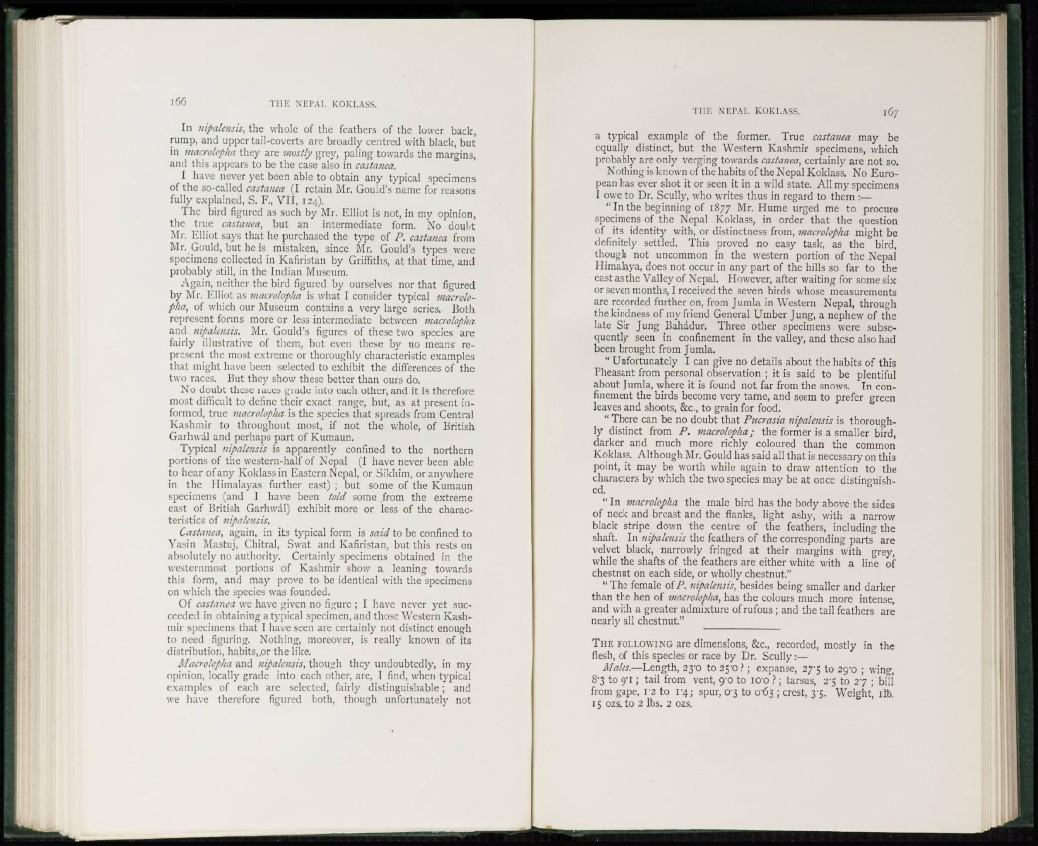
Ill nipalensis, the whole of the feathers of the lower back,
rump, and upper tail-coverts are broadly centred with black, but
in macrolopha they are mostly grey, paling towards the margins,
and this appears to be the case also in castanca.
I have never yet been able to obtain any typical specimens
of the so-called castanca (I retain Mr. Gould's name for reasons
fully explained, S. F., V I I , 124).
The bird figured as such by Mr. Elliot is not, in my opinion,
the true castanca, but an intermediate form. No doubt
Mr. Elliot says that he purchased the type of P. castanca from
Mr. Gould, but he is mistaken, since Mr. Gould's types were
specimens collected in Kafiristan by Griffiths, at that time, and
probably still, in the Indian Museum.
Again, neither the bird figured by ourselves nor that figured
by Mr. Elliot as macrolopha is what I consider typical macrolopha,
of which our Museum contains a very large series. Both
represent forms more or less intermediate between macrolopha
and nipalensis. Mr. Gould's figures of these two species are
fairly illustrative of them, but even these by 110 means represent
the most extreme or thoroughly characteristic examples
that might have been selected to exhibit the differences of the
two races. But they show these better than ours do.
No doubt these races grade into each other, and it is therefore
most difficult to define their exact range, but, as at present informed,
true macrolopha is the species that spreads from Central
Kashmir to throughout most, if not the whole, of British
Garhwil and perhaps part of Kumaun.
Typical nipalensis is apparently confined to the northern
portions of the western-half of Nepal (I have never been able
to bear of any Koklassin Eastern Nepal, or Sikhim, or anywhere
in the Himalayas further east) ; but some of the Kumaun
specimens (and I have been told some from the extreme
east of British Garhwal) exhibit more or less of the characteristics
of nipalensis.
Castanca, again, in its typical form is said to be confined to
Yasin Mastuj, Chitral, Swat and Kafiristan, but this rests on
absolutely no authority. Certainly specimens obtained in the
westernmost portions of Kashmir show a leaning towards
this form, and may prove to be identical with the specimens
011 which the species was founded.
Of castanca we have given no figure ; I have never yet succeeded
in obtaining a typical specimen, and those Western Kashmir
specimens that I have seen are certainly not distinct enough
to need figuring. Nothing, moreover, is really known of its
distribution, habits,.or the like.
Macrolopha and nipalensis, though they undoubtedly, in my
opinion, locally grade into each other, are, I find, when typical
examples of each are selected, fairly distinguishable ; and
we h a v e therefore figured both, though unfortunately not
a typical example of the former. True castanca may be
equally distinct, but the Western Kashmir specimens, which
probably are only verging towards castanca, certainly are not so.
Nothing is known of the habits of the Nepal Koklass. No European
has ever shot it or seen it in a wild state. All my specimens
I owe to Dr. Scully, who writes thus in regard to them :—
" In the beginning of 1877 Mr. Hume urged me to procure
specimens of the Nepal Koklass, in order that the question
of its identity with, or distinctness from, macrolopha might be
definitely settled. This proved no easy task, as the bird,
though not uncommon in the western portion of the Nepal
Himalaya, does not occur in any part of the hills so far to the
east as the Valley of Nepal. However, after waiting for some six
or seven months, I received the seven birds whose measurements
arc recorded further on, from Jumla in Western Nepal, through
the kindness of my friend General Umber Jung, a nephew of the
late Sir Jung Bahadur. Three other specimens were subsequently
seen in confinement in the valley, and these also had
been brought from Jumla.
" Unfortunately I can give no details about the habits of this
Pheasant from personal observation ; it is said to be plentiful
about Jumla, where it is found not far from the snows. In confinement
the birds become very tame, and seem to prefer green
leaves and shoots, &c, to grain for food.
" There can be no doubt that Pucrasia nipalensis is thoroughly
distinct from P. macrolopha; the former is a smaller bird,
darker and much more richly coloured than the common
Koklass. Although Mr. Gould has said all that is necessary on this
point, it may be worth while again to draw attention to the
characters by which the two species may be at once distinguished.
" I n macrolopha the male bird has the body above the sides
of neck and breast and the flanks, light ashy, with a narrow
black stripe down the centre of the feathers, including the
shaft. In nipalensis the feathers of the corresponding parts are
velvet black, narrowly fringed at their margins with grey,
while the shafts of the feathers are either white with a line of
chestnut on each side, or wholly chestnut."
" The female of P. nipalensis, besides being smaller and darker
than the hen of macrolopha, has the colours much more intense,
and with a greater admixture of rufous ; and the tail feathers are
nearly all chestnut."
T H E FOLLOWING are dimensions, &c., recorded, mostly in the
flesh, of this species or race by Dr. Scully :—
Males.—Length, 23'0 to 25'O? ; expanse, 27-5 to 29-0 ; wing,
8-3 to 9T ; tail from vent, 9-0 to IO'O ?; tarsus, 2-5 to 27 ; bill
from gape, 12 to 14; spur, 03 to 0-63 ; crest, 35. Weight, lib.
15 ozs. to 2 lbs. 2 ozs.